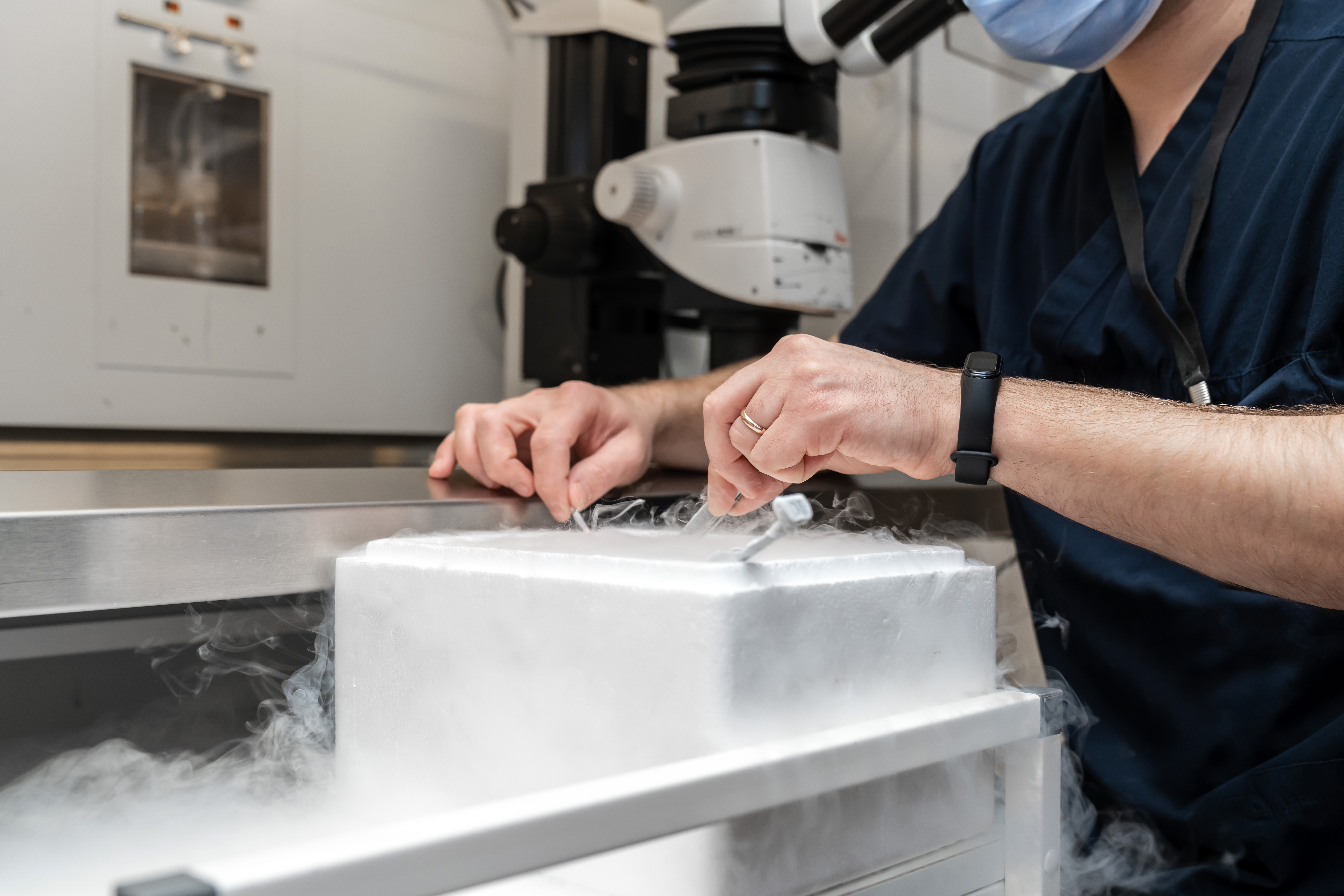During my career as a licensed massage therapist, countless people have opened up to me while in treatment. One vent session in particular stood out to me, as it completely changed my view of the in vitro fertilization (IVF) industry.
It happened a few years ago when a 30-something woman told me about researching her ancestry with her paternal grandfather. She did a popular DNA saliva test, hoping for more insight into her family’s lineage and medical histories. Instead, the test results tore her family apart.
The moment she learned her Dad wasn’t her father
The DNA test showed that the man she had called Dad her whole life (who had passed away several years before) was not actually her father at all. When confronted, her baffled mother was understandably upset but then remembered the fine print on the in vitro fertilization documents she and her husband had signed decades earlier, when IVF was still in its infancy.
As it turned out, the IVF agreement stated that the facility would combine the husband’s semen with that of a sperm donor, claiming it could potentially “strengthen” the husband’s sample. As you can probably guess, it was the donor’s sperm that ended up fertilizing the woman’s egg—not the husband’s.
While the couple had questioned the logic behind using another man’s semen during the IVF process, the doctors at the time assured them that it would indeed be the husband’s sperm that created the embryo. Hopeful for a family and trusting of the medical system, the couple signed on the dotted line. They conceived, had a healthy baby, and didn’t think about the fine print again for the next thirty years.
Are the IVF industry’s sketchy business practices a thing of the past?
The news of the DNA test shook the entire family. The young woman learned her father wasn’t actually related to her at all—nor was the grandfather with whom she had been doing the family research. Her mother came to the disturbing realization that she was impregnated by a man she had never met, and carried and raised this stranger’s child, all while thinking her daughter was a product of her and her husband’s loving marriage.
Each of the people involved had to process this massive news and grieve the life they thought they had for the past 30-plus years, as a direct result of the IVF industry’s sketchy and manipulative practices.
The IVF process treats preborn people like products to be bought and sold
Sadly, this family is not alone in suffering from a process riddled with ethical pitfalls and very little regulation. To the casual observer, IVF may appear to be nothing short of a modern-day miracle for couples struggling to conceive—but the future, not the present, generation pays the price. In fact, a staggering 62% of children conceived through donor technologies such as surrogacy and IVF consider the exchange of money for gametes to be wrong and 48.5%, upon learning of their method of conception, sought psychological help, according to a Harvard Medical School study.
The fact is, IVF is still a new industry. The first baby successfully conceived and brought to term through IVF technology was born in 1978—a mere 46 years ago. Over those past 46 years, technology has developed rapidly—so rapidly that our legislation and our moral compasses can’t keep up.
Couples approaching IVF want to have a family but are unable (or have been told they’re unable) to do so naturally. Wanting a family is a natural and worthy desire. Thus, many believe that any method of conceiving a child is justified—even if it means treating children as commodities. Even with the best of intentions, the process of conceiving through IVF has a dark side. As tempting as it is to conclude that the ends justify the means when it comes to IVF, it may be time to reevaluate the way we see the industry.
How lab technicians make babies
Let’s start with a crash course on how babies are made through IVF. The process begins by giving the woman hormone injections to stimulate the ovaries to grow the eggs, and then retrieving eggs from the woman’s ovaries. A needle is inserted into the vagina, and her eggs are suctioned out. The number of eggs retrieved varies greatly, but let’s say 10 eggs are retrieved from a patient. Those eggs are then fertilized using the male partner’s sperm sample, which is most often collected through masturbation and the use of pornographic material. Approximately 80 percent of the retrieved eggs become fertilized (now called “zygotes”), which are placed inside an incubator that simulates a woman’s fallopian tubes (bringing the sample to about eight). Approximately 30-50% of the zygotes will reach the blastocyst (i.e., transferrable) stage, which would leave our imaginary couple with roughly three to five viable blastocysts by this point in the process.
Survival of the fittest: how embryos are selected
At this point, many couples choose to put their blastocysts (often colloquially called “embryos” by now, although the embryo stage doesn’t technically begin until implantation has occurred) through chromosomal screening, better known as preimplantation genetic testing (PGT). PGT is the process by which embryos are “graded” based on certain criteria. PGT allows couples to find out each embryo’s gender, and to become aware of any abnormalities that may exist in each. In many cases, embryos with chromosomal abnormalities are discarded. In some cases, even embryos of an undesired gender may be discarded. While sex-selective and other discriminatory screening practices are illegal in most countries, thousands of people travel to the US each year to select embryos based on gender, physical traits, chromosomal abnormalities, and a slew of other possible health conditions.
These couples likely believe they’re giving their child a chance at the best life possible by choosing the “strongest” embryo and knowing in advance which health issues they might face. In the process, however, they destroy the other offspring they created, simply because they don’t quite “measure up” to their siblings.
It can be easy to lose sight of the fact that it’s not just “clumps of cells” being analyzed and graded by the IVF process, but human beings whose delicate lives rest in the hands of a team of embryologists. Instead of a sacred, life-giving process, IVF necessitates a numbers game of probability and chance, resulting in the unceremonious and ironic disposal of the very embryos a couple could once only dream of creating. As they grow up, will children conceived in this way continue to face expectations that they “perform” and “compete” in order to prove their worthiness to live?
Who holds the IVF industry accountable?
But the ethical problems concerning IVF don’t end there. On the whole, the entire industry is notoriously underregulated, leading to unthinkable tragedies for couples all over the country.
For example, earlier this year, nine couples brought a lawsuit against an Orange County IVF clinic that allegedly “knowingly implanted dead embryos into would-be mothers and then tried to conceal the laboratory mistakes that had poisoned the embryos.” The couples involved in the lawsuit were saddened when their implantations failed but then became suspicious when they learned the clinic had a 100% failure rate for implantations over a two-week period. These couples are now not only coping with the fact that that particular transfer failed; their other embryos have been destroyed due to the clinic’s recklessness as well.
How could this happen? Don’t IVF clinics have to follow professional and legal standards just like other medical specialties? One reason this can happen is the lack of coherent federal or state regulations, leading primarily to the IVF industry self-policing (or not). For instance, this 2018 study of a large IVF laboratory showed an exemplary record with scant mistakes or “nonconformances,” but was conducted by that same IVF clinic [1]. Certainly, standards created by the American Society of Reproductive Medicine exist, but unlike with other areas of medicine, following them is voluntary and there are no legal or professional penalties for failing to do so. The Society for Associated Reproductive Technology accredits IVF clinics, but they are not required to secure accreditation.
What’s more, the only federal law specific to the IVF industry mandates reporting of live birth success rates at just over 450 clinics nationwide. But the most recent statistics on the Centers for Disease Control and Prevention (CDC) website are already three years old, hardly real-time data and, again, there is no consequence of failure to self-report.
IVF clinics aren’t mandated to report mistakes
As Dov Fox, the director of the Center for Health Law Policy and Bioethics at the University of San Diego, explained to the Washington Post, “In other areas of health care, states require hospitals to monitor and report major avoidable errors, things like mismatched blood transfusions or surgery on the wrong body part. They call these ‘never events’ because these are things that just shouldn’t happen. No agency or authority tracks or polices what might be called ‘reproductive never events.’”
The lack of mandated reporting of IVF clinic mistakes (ranging from mislabeling of specimens to cryopreservation freezer failures leading to the destruction of hundreds or thousands of eggs and embryos) means other couples considering IVF are essentially shooting in the dark when they sign on the dotted line, to the tune of tens of thousands of dollars. Also from WaPo, “most lawsuits result in settlements with nondisclosure provisions, reinforcing the secrecy that surrounds the multibillion-dollar fertility industry. Many cases are settled even before lawsuits are filed, attorneys said.”
How often do mistakes occur?
Adam Wolf is a San Francisco-based lawyer well known for representing couples seeking to hold the IVF industry accountable. Wolf told WaPo, “The vast, vast supermajority of mistakes in fertility clinics, the public doesn’t even know about. Without data on errors, it is impossible to measure the quality of U.S. reproductive care.”
One 2022 study found that in the previous 15 years, 9 cryopreservation tank failures impacted over 1,800 patients and over 8,000 eggs or embryos in the U.S. The more common mistake, though, is the mislabeling of specimens, meaning that Couple A’s embryo may be implanted in Couple B’s wife’s womb.
Abortion, freezer storage, and “compassionate transfers:” the parts of IVF no one wants to talk about
Since IFV has such a low success rate (roughly 50% for women under 35, and lower among women who are older), most patients choose to create many more embryos than they intend to implant. In fact, using CDC data, Catholic News Agency estimates that somewhere between a whopping 1.5 million and 1.8 million embryos created through IVF in 2021 alone were never born. These numbers are comparable with research from 2018 showing that 2.5 million IVF cycles are conducted annually worldwide, but only 500,000 children were born. As such, the new moral dilemma becomes what to do with the “extra” created embryos.
The most common solution is to destroy the embryos. Understandably, many couples—particularly those who are pro-life—are opposed to destroying their embryos. In that case, some choose to keep their unused embryos in rented-out freezer facilities. But is keeping your unborn child in cold storage indefinitely really that much better than destroying them? At some point, most couples have to face the fact that they can’t keep holding on to embryos they have no intention of using. When that happens, most decide to dispose of them, ending the lives they created without giving them a chance.
A “compassionate transfer” is a lesser-known option for couples wondering what to do with their embryos. The process involves intentionally implanting an embryo at a time in the woman’s cycle when pregnancy is not likely to occur. As a result, the embryo dies, making the procedure feel like a roundabout (and pricey) way to arrive at the same conclusion as simply disposing of them.
What happens to “extra” embryos when couples divorce?
The issue of what to do with the embryos in the case of divorce has also been called into question in recent years. Courts are conflicted on whether to treat the embryos as human beings or as property. If a woman is granted custody of the embryos she and her ex-husband created while they were married, does she have the right to implant those embryos even after they’re divorced? Conversely, if the husband is granted custody, is he legally allowed to implant them in a different woman without his ex-wife’s consent? What if one of them wants to dispose of the embryos and the other wants to keep them in storage or donate them? None of these complicated questions have clear-cut answers. Meanwhile, the fate of the couple’s preborn babies hangs in the balance.
Planting a garden of… children?
Donating the unused embryos is another option. On the one hand, some couples see donation as a way for their embryos to have a chance at life. But for many, the idea of having offspring out in the world while they play no part in their lives doesn’t sit right. Most people feel an innate moral obligation to play a role in the lives of their biological children, and that likely isn’t an option with embryo donations.
One particularly disturbing trend for parents struggling with what to do with their embryos is to plant the preborn children in a garden, saying they’re letting their child’s legacy live on by nourishing the earth so new life can grow. An Australian company takes the concept of “creating something new” out of the embryos a step further by turning them into jewelry.
As the company’s founder Amy McGlade flippantly explains it: “What better way to celebrate your most treasured gift, your child, than through jewelry?” But isn’t the only fitting way to “celebrate” your child giving them a chance at life?
The bottom line
From the “anything goes as long as you pay” mentality to the lack of laws and regulations for IVF providers, it’s time to “settle” the Wild West of reproductive medicine. It’s time to take a closer look at the ethics of IVF and the business practices of the IVF industry. We need to ask ourselves if we have the right to play God by deciding who has a chance at life simply because we have the technology to do so. We need more laws in place to protect the rights of our country’s tiniest inhabitants, in and out of the womb. And we need greater societal awareness of ethical, effective alternatives to IVF for infertile couples, so that they know in vitro fertilization isn’t their only option.
Those who’ve conceived through IVF also need to know they have a chance of conceiving naturally in the future. Couples whose embryos have been lost, mislabeled, wrongly implanted, or accidentally destroyed deserve accountability from the IVF industry. And couples who are considering IVF deserve unbiased, fact-based transparency about risks, including the risk of mistakes and their rights to legal recourse, before signing on the dotted line.
This article was last updated on 7/22/2024 to reflect more accurate figures underneath the heading “How lab technicians make babies,” and to clarify the terminology in each developmental stage of early life under “How lab technicians make babies” and “Survival of the fittest: how embryos are selected.”
Additional Content:
NW Podcast Ep 8: Why this former top IVF doc now only offers restorative reproductive medicine
The dark side of the IVF industry, from a survivor
References:
[1] Sakkas D, Barrett CB, Alper MM. Types and frequency of non-conformances in an IVF laboratory. Hum Reprod. 2018 Dec 1;33(12):2196-2204. doi: 10.1093/humrep/dey320. PMID: 30388228. [2] Murphy, Anar & Gollapud, Sindhu & Collins, Michael. (2022). Legal Case Study Of Severe IVF Incidents Worldwide: Causes, Consequences, And High Emotional, Financial, And Reputational Costs To Patients And Providers. North American Proceedings in Gynecology & Obstetrics. 2. 10.54053/001c.37563. [3] Fauser BC. Towards the global coverage of a unified registry of IVF outcomes. Reprod Biomed Online. 2019 Feb;38(2):133-137. doi: 10.1016/j.rbmo.2018.12.001. Epub 2018 Dec 14. PMID: 30593441.






